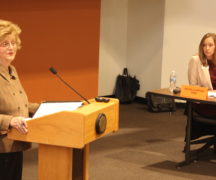By DAVID DUPONT
BG independent News
Students entering Bowling Green State University will know what their costs will be for their next four years on campus thanks to the new Falcon Tuition Guarantee approved by the Board of Trustees Friday.
Sheri Stoll, BGSU chief financial officer, said the plan will allow families to know ahead of time what their costs will be. The guarantee will only apply to the class coming in fall, and each subsequent class. The guarantee is for four years, though extensions for programs that require more than 122 credit hours to complete will be available.
Covered by the guarantee are tuition, room and board, mandatory fees, and out-of-state surcharge fees.
Among the items not covered are any optional fees, such as legal, green, and media fees, fees for high cost programs, such as aviation, or study abroad. Parking permits and fines are also not covered. Fees related to clubs and extracurricular activities are also not included.
Stoll said she was initially “cautious” about the prospect of the guarantee. “I’m starting to feel some excitement,” she said. “For our families this could be a good thing. The unpredictability is something they struggle with.”
The legislature has been pushing public universities to establish guarantees by allowing those with guarantees to raise tuition while freezing it at other schools.
Stoll said that most public universities are expected to establish guarantees.
What price those students will pay must still be approved by trustees. Stoll said she expects to present a proposal for tuition in May. The trustees will also act on establishing room and board and fees.
The last time BGSU raised tuition and general fees was fall, 2013.
Earlier at the meeting, Thomas Gibson, vice president for student affairs and vice provost, said that money is the biggest reason students leave BGSU. “Many return to an institution nearby home so they can commute.”
Some of those students, Provost Rodney Rogers said, are excelling academically. The university is looking at ways to provide them with more scholarship aid to keep them on campus.
Some students, Gibson said, leave because they question whether they are prepared for college, while others enlist in the military.
“A very small” number don’t feel there’s a good fit between themselves and the university.
The university, Rogers said, is making strides in retaining students. The goal is to have 80 percent students who enroll as freshmen stay for their sophomore year. Last year that number was 76 percent.
Gibson said that the number of students who “persisted” from their first to the second semester appears to be well over 90 percent, and that’s a good sign for attaining the retention goal.
Students in the College of Technology and College of Business have the highest retention rates. Undecided students, Rogers said, have the lowest.





